عندما يتعلق الأمر بأدوات القطع، هناك مادتين تظهران مرارًا وتكرارًا: كربيد التنغستن والفولاذ عالي السرعة (HSS).
إذا كنت تتساءل عن أيهما أفضل لعملك، فإن الإجابة تعتمد على ما تقدره أكثر - السرعة، أو المتانة، أو الميزانية.
ولكن إذا كنت تريد أدوات تدوم طويلاً، وأداءً أفضل، وتشغيلًا أسرع، فإن كربيد التنغستن هو الفائز الواضح.
في هذا الدليل، سنشرح كل شيء بشكل مبسط. ستتعلم الفرق بين كربيد التنغستن وHSS، ومتى يُستخدم كل منهما، ولماذا تُعدّ أدوات القطع المصنوعة من الكربيد أفضل لمعظم التطبيقات الحديثة.
1. ما هو الفولاذ عالي السرعة (HSS)؟
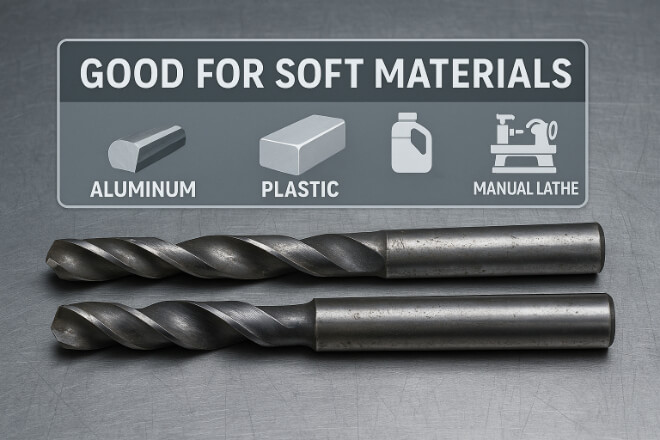
الفولاذ عالي السرعة هو نوع من الفولاذ المُقسّى يُستخدم في أدوات القطع منذ عقود. يُعرف بمتانته وسعره المناسب وسهولة شحذه.
تعمل أدوات HSS بشكل أفضل عند قطع المواد الناعمة والمتوسطة مثل:
الألومنيوم
الفولاذ الطري
بلاستيك
خشب
وهي شائعة في الأدوات اليدوية، ورؤوس المثقاب، والآلات منخفضة السرعة.
مميزات HSS:
سعر منخفض
من السهل إعادة طحنها أو إعادة تشكيلها
قوي (أقل عرضة للتشقق)
لكن أدوات الفولاذ عالي السرعة تفقد حدتها بسرعة، خاصةً عند السرعات العالية أو عند قطع المعادن الصلبة. كما أنها لا تتحمل الحرارة بكفاءة الكربيد.
2. ما هو كربيد التنغستن؟
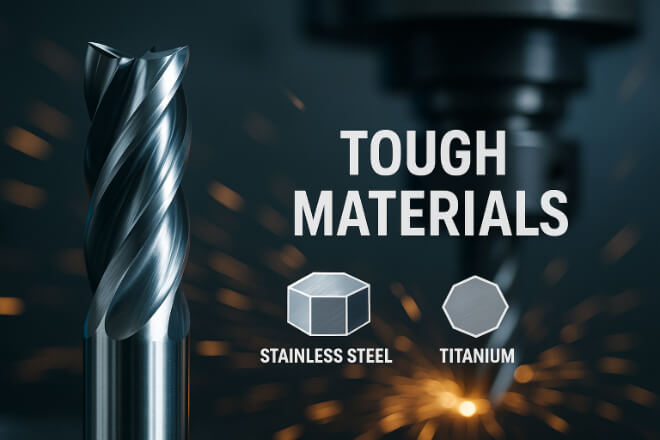
كربيد التنغستن مادة شديدة الصلابة، مصنوعة من مزيج من التنغستن ومسحوق الكربون. وهي أصلب بكثير من الفولاذ عالي السرعة (HSS)، وتحافظ على حدتها لفترة أطول.
تُستخدم أدوات الكربيد على نطاق واسع في:
تصنيع باستخدام الحاسب الآلي
الطحن عالي السرعة
الحفر الدقيق
قطع المواد الصلبة (مثل الفولاذ المقاوم للصدأ والتيتانيوم والحديد الزهر)
فوائد أدوات القطع المصنوعة من كربيد التنغستن:
ابقى حادًا لفترة أطول
قطع أسرع مع دقة أفضل
التعامل مع الحرارة وارتداء أفضل
ممتاز للمواد الصلبة أو الكاشطة
تكلف أدوات الكربيد أكثر مقدمًا، لكنها تدوم لفترة أطول وتقدم نتائج أفضل - خاصة في الأعمال ذات الحجم الكبير أو الدقة.
3. الاختلافات الرئيسية: كربيد التنغستن مقابل الفولاذ عالي السرعة
| ميزة | كربيد التنغستن | الفولاذ عالي السرعة |
|---|---|---|
| صلابة | عالية جدًا – تبقى حادة لفترة أطول | متوسط – يبهت بشكل أسرع |
| مقاومة الحرارة | ممتاز | جيد |
| سرعة القطع | سريع جدا | أبطأ |
| أداة الحياة | أطول من 5 إلى 10 مرات | أقصر |
| قوة الحافة | حاد جدًا ولكنه أكثر هشاشة | أقوى، يمكن أن ينحني |
| يكلف | أعلى مقدما | الجزء الأمامي السفلي |
| أفضل استخدام | المواد الصلبة، التحكم الرقمي بالحاسوب، الإنتاج | المعادن اللينة، الأعمال الخفيفة، الأدوات اليدوية |
4. لماذا يُعد كربيد التنغستن أفضل (لمعظم الوظائف)
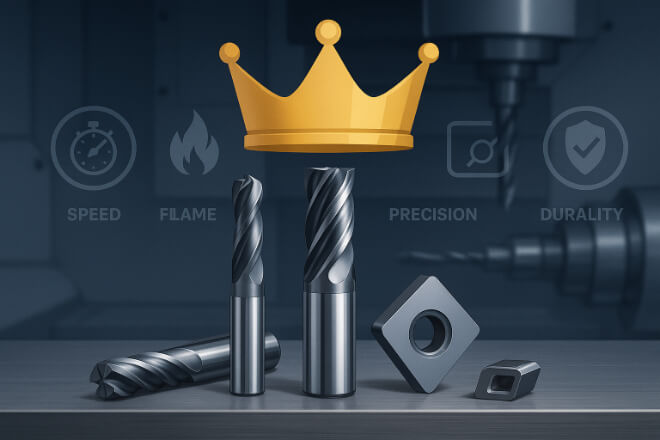
1). يدوم لفترة أطول بكثير
تتفوق أدوات الكربيد على أدوات HSS بفارق كبير، إذ غالبًا ما تكون أطول بخمس إلى عشر مرات. هذا يعني تقليل تغيير الأدوات، وتقليل وقت التوقف عن العمل، وتقليل عمليات الاستبدال.
2). قطع أسرع
بفضل صلابتها ومقاومتها للحرارة، تُنجز أدوات كربيد التنغستن عمليات قطع أسرع بكثير. ستتمكن من إنجاز المزيد من العمل في وقت أقل، خاصةً على ماكينات CNC.
3). يتعامل مع الحرارة بشكل أفضل
الحرارة سبب رئيسي لتآكل الأدوات. يبقى الكربيد متينًا في درجات الحرارة العالية، لذا يُحسّن أداءه في القطع الجاف أو التشغيل عالي السرعة.
4). أفضل للمواد الصلبة
الفولاذ المقاوم للصدأ والتيتانيوم والسبائك المقواة - هذه مواد متينة تُسبب تآكلًا سريعًا لأدوات الفولاذ عالي السرعة. صُمم الكربيد لهذه الأغراض.
5). تشطيبات أنظف
تُنتج أدوات الكربيد أسطحًا أكثر نعومةً وقطعًا أكثر دقة. وهذا مهمٌّ عند الحاجة إلى تحمّلات دقيقة أو لمسة نهائية مصقولة.
6). أكثر كفاءة
نعم، أدوات الكربيد أغلى ثمناً، لكنها توفر لك المال مع مرور الوقت. فالعمر الأطول، والأداء الأفضل، وتغييرات الأدوات الأقل، كلها عوامل تُقلل التكلفة الإجمالية لكل قطعة.
5. عندما لا يزال الفولاذ عالي السرعة منطقيًا
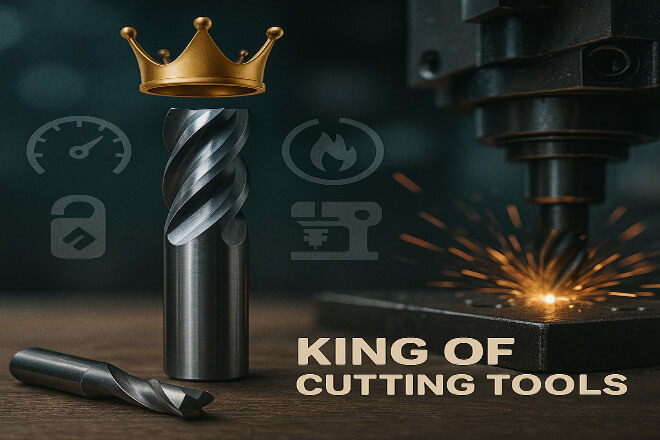
للإنصاف، ليس نظام HSS عديم الفائدة. بل لا يزال له قيمة في بعض الوظائف، خاصةً في الحالات التالية:
الميزانية محدودة
قطع المعادن اللينة
استخدام الآلات اليدوية
يتم إعادة شحذ الأدوات في كثير من الأحيان
الوظائف ذات الحجم المنخفض أو لمرة واحدة
إذا كنت تقوم بقطع البلاستيك أو الألومنيوم أو الخشب، أو كنت لا تحتاج إلى سرعة عالية، فقد يكون HSS جيدًا بما فيه الكفاية.
ولكن في معظم إعدادات الإنتاج، يعمل الكربيد بشكل أفضل.
6. حالات الاستخدام في العالم الحقيقي
| طلب | أفضل أداة | لماذا |
|---|---|---|
| تصنيع باستخدام الحاسب الآلي | كربيد التنغستن | سرعة عالية، عمر طويل، وتحملات ضيقة |
| قطع الفولاذ المقاوم للصدأ | كربيد التنغستن | يقاوم الحرارة والتآكل |
| مخرطة يدوية على الألومنيوم | HSS | منخفضة التكلفة وسهلة إعادة الطحن |
| مكونات الفضاء الجوي | كربيد التنغستن | مطلوب لأجزاء التيتانيوم والدقة |
| ورشة عمل اصنعها بنفسك | HSS | مناسب للميزانية للاستخدام العرضي |
7. الأساطير الشائعة (مُدَحَّقَة)
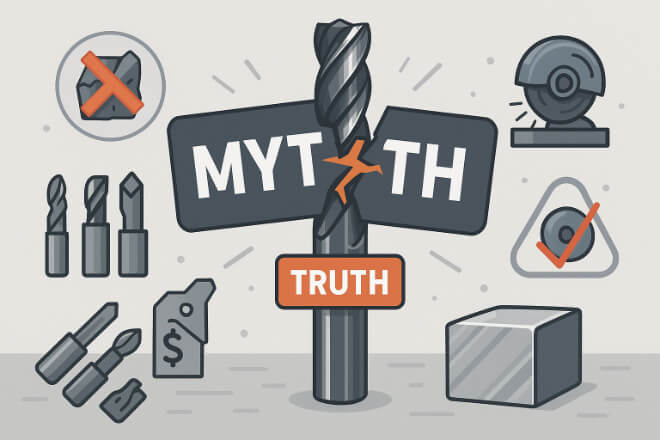
الأسطورة رقم 1: الكربيد ينكسر بسهولة.
غير صحيح. أصناف الكربيد الحديثة أكثر صلابةً وموثوقيةً من أي وقت مضى. مع الاستخدام السليم، تتمتع بأداءٍ ممتاز حتى في أصعب المهام.
الأسطورة 2: HSS جيد بنفس القدر إذا تم شحذه.
إن الشحذ يساعد، لكنه لن يغير حقيقة أن HSS يتآكل بشكل أسرع ويقطع بشكل أبطأ.
الأسطورة 3: الكربيد مخصص فقط للمتاجر الكبيرة.
خطأ أيضًا. تستخدم العديد من المتاجر الصغيرة والمتوسطة أدوات الكربيد لأنها توفر قيمة أفضل بمرور الوقت.
الحكم النهائي: كاربايد يفوز
إذن، ما هي أداة القطع الأفضل- كربيد التنغستن أم الفولاذ عالي السرعة؟
إذا أردت:
عمر أطول للأداة
تصنيع أسرع
تحسين تشطيب السطح
انخفاض التكلفة على المدى الطويل
أداء عالي في المواد الصلبة
ومن ثم فإن كربيد التنغستن هو الخيار الأفضل على ما يبدو.
لا يزال الفولاذ عالي السرعة يعمل في حالات معينة، وخاصة عند قطع المواد اللينة أو العمل باليد.
ولكن بالنسبة للتصنيع الجاد - وخاصة باستخدام الحاسب الآلي - فإن أدوات الكربيد تتفوق على HSS في كل شيء تقريبًا.
هل تحتاج إلى مساعدة في اختيار الأدوات المناسبة لجهازك؟ تواصل معنا إعادة للحصول على إرشادات من الخبراء أو حل كربيد مخصص.
